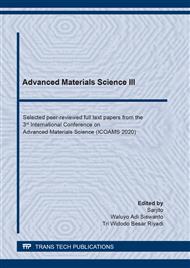[1]
S. Wang, G. Dai, H. Yang, Z. Luo, Lignocellulosic biomass pyrolysis mechanism: A state-of-the-art review, Energy. Combust. Sci., 62 (2017), 33-86.
DOI: 10.1016/j.pecs.2017.05.004
Google Scholar
[2]
B. Biswas, N. Pandey, Y. Bisht, R. Singh, J. Kumar, T. Bhaskar, Pyrolysis of agricultural biomass residues: Comparative study of corn cob, wheat straw, rice straw and rice husk, Bioresource Technology 237 (2017) 57-63.
DOI: 10.1016/j.biortech.2017.02.046
Google Scholar
[3]
N. Abdullah, H. Gerhauser, F. Sulaiman, Fast pyrolysis of empty fruit bunches, Fuel 89 (8) (2010) 2166-2169.
DOI: 10.1016/j.fuel.2009.12.019
Google Scholar
[4]
S. Stegen, P. Kaparaju, Effect of temperature on oil quality obtained through pyrolysis of sugarcane bagasse, Fuel 276 (2020) 118112.
DOI: 10.1016/j.fuel.2020.118112
Google Scholar
[5]
F.L. Tibola, T.J.P. de Oliveira, W.S. Carvalho, C.H. Ataide, C.R. Cardoso, Coffee Husks Characterization for the Fast Pyrolysis Process, Materials Science Forum 899 (2017) 130-135.
DOI: 10.4028/www.scientific.net/msf.899.130
Google Scholar
[6]
J. Zheng, W. Yi, N. Wang, Bio-oil production from cotton stalk, Energy Conversion and Management, 49 (6) (2008) 1724-1730.
DOI: 10.1016/j.enconman.2007.11.005
Google Scholar
[7]
P. Kumar, P. Kumar, P.V.C. Rao, N.V. Choudary, G. Sriganesh, Saw dust pyrolysis: Effect of temperature and catalysts, Fuel 199 (2017) 339-345.
DOI: 10.1016/j.fuel.2017.02.099
Google Scholar
[8]
S.H. Chang, An overview of empty fruit bunch from oil palm as feedstock for bio-oil production, Biomass and Bioenergy 62 (2014) 174-181.
DOI: 10.1016/j.biombioe.2014.01.002
Google Scholar
[9]
R. French, S. Czernik, Catalytic pyrolysis of biomass for biofuels production. Fuel Process Technol 91(1) (2010) 25-32.
DOI: 10.1016/j.fuproc.2009.08.011
Google Scholar
[10]
G. Kabir, B.H. Hameed, Recent progress on catalytic pyrolysis of lignocellulosic biomass to highgrade bio-oil and bio-chemicals, Renewable and Sustainable Energy Reviews 70 (2017) 945–967.
DOI: 10.1016/j.rser.2016.12.001
Google Scholar
[11]
E. Taarning, C.M. Osmundsen, X. Yang, B. Voss, S.I. Andersen, C.H. Christensen, Zeolite-catalyzed biomass conversion to fuels and chemicals, Energy Environ Sci, 4 (2011), 793.
DOI: 10.1039/c004518g
Google Scholar
[12]
V.K. Guda, H. Toghiani, Catalytic pyrolysis of pinewood using metal oxide catalysts in an integrated reactor system, Biofuels, 8 (2017), 527-536.
DOI: 10.1080/17597269.2016.1231960
Google Scholar
[13]
V.G. Komvokis, S. Karakoulia, E.F. Iliopoulou, M.C. Papapetrou, I.A. Vasalos, A.A. Lappas, K.S. Triantafyllidis, Upgrading of Fischer–Tropsch synthesis bio-waxes via catalytic cracking: effect of acidity, porosity and metal modification of zeolitic and mesoporous aluminosilicate catalysts, Catal Today, 196 (2012), 42-55.
DOI: 10.1016/j.cattod.2012.06.029
Google Scholar
[14]
K. Lazdovica, L. Liepina, V. Kampars, Catalytic pyrolysis of wheat bran for hydrocarbons production in the presence of zeolites and noble-metals by using TGA-FTIR method, Bioresour Technol, 207 (2016), 126-133.
DOI: 10.1016/j.biortech.2016.01.117
Google Scholar
[15]
Y. Xiao, A. Varma, Conversion of glycerol to hydrocarbon fuels via bifunctional catalysts, ACS Energy Lett, 1 (2016), .963-968.
DOI: 10.1021/acsenergylett.6b00421
Google Scholar


